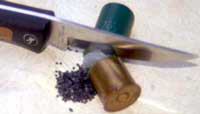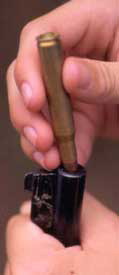
A few decades ago, it would have been difficult to find an outdoorsman who couldn't start a campfire. Wood cookstoves and heating were used by almost everyone, and campfires brightened every outdoor adventure. Fire building was part of everyday life.
 That has changed, of course. Push a button and you can microwave dinner. Turn up the thermostat and, presto, you have heat. Want a fire in the fireplace? Light a store-bought firestarter and you don't even need kindling.
That has changed, of course. Push a button and you can microwave dinner. Turn up the thermostat and, presto, you have heat. Want a fire in the fireplace? Light a store-bought firestarter and you don't even need kindling.
Not surprisingly, many people no longer can build even the most rudimentary fire. For most, this will never be more than a minor inconvenience. But in a survival situation, the importance of fire cannot be exaggerated. Fire provides heat to prevent hypothermia, to cook food, to purify water and to dry clothes. It can serve as a rescue signal or night light, even a morale booster.
A lost hunter or stranded fisherman facing several cold nights in the boondocks needs all the cheer he can extract from his crisis, and a camp without a campfire is anything but cheerful. A fire warms not only the body but the spirit as well.

The smart woodsman always carries waterproof matches like Coghlan's Waterproof Matches, a butane lighter or the popular Ultimate Survival Technologies TekFire Fuel-Free Lighter and other fire-starting tools. He lays his fire where wind, water and other elements won't interfere with its building. He can find dry tinder even in wet weather and knows to build the fire in stages, beginning with tinder and working steadily to twigs, branches and larger pieces of wood as quickly as the fire and conditions allow. He practices fire building, even under adverse conditions, to assure he's prepared in an emergency.

TekFire Fuel-Free Lighter
Let's suppose you are that woodsman. But — uh, oh — you forgot the matches and lighter. Or suppose your matches aren't waterproof and they've gotten wet. Or the butane in the lighter is exhausted. Would you still be prepared? Could you build a fire if your life depended on it?
The following methods of emergency fire-building are difficult to use, even under ideal conditions. But in a survival situation without any other means of lighting a fire, they could save your life.
Before beginning, have plenty of dry tinder, kindling and firewood at hand. Never win a flame and then have to run around looking for fuel.
Good ingredients for tinder include lint (check your pockets and belly button), cotton threads, dry-wood powder, unraveled string, wool fuzz, bits of bird or mouse nests, dry shredded bark or pine needles and slivers of fat pine. Consider anything for kindling: dollar bills and other paper in your wallet, pine cones, twigs, wood shavings, split dry bark, dry bunches of grass. Be prepared for failures, but don't give up.
Infinite patience and innovation are now your allies.
1. The Empty Lighter
Don't throw away your disposable lighter just because the butane is exhausted. Remove the metal hood surrounding the gas-port, and the lighter can serve as a spark-thrower to ignite fine tinder. If you have it, a few drops of gasoline or grains of gunpowder mixed with the tinder may help in lighting it.
Shelter the tinder in a small ball of dried grass, pine needles or cotton cloth, and strike the flint wheel to throw sparks on it. When a spark catches, making the tinder glow, blow gently to produce a flame. Continue sheltering the flame, and add bits of tinder and small kindling until the fire is burning.
2. Lenses Can Be Used to Start Fires

Every school child knows a magnifying glass can focus sunlight and start a fire. On sunny days, lenses from a rifle scope, binoculars, a camera or prescription eyeglasses can sometimes be used the same way.
Focus the sun's rays through the lens to a pinpoint on some tinder, and it soon should start to smolder. Blow or fan gently to produce a flame.
If one lens won't create a hot pinpoint of light, try using two together, turning and separating them until you get the proper result. Survivors have even been known to start fires using sunlight shining through a piece of shaped ice
3. Vehicle Parts & Fuel are Fire-Starting Items

If your vehicle has broken down or you've been in a plane crash, chances are fire-starting items will be at hand, including, perhaps, highway flares, a Orion Marine Handheld Signal Flare or a cigarette lighter in the dashboard.
Gasoline can be used in small amounts to assist in fire-building. Remove the air cleaner, stuff a piece of cloth down the carburetor, then pump the accelerator pedal to squirt gas on the cloth. If necessary, obtain larger quantities of fuel by removing a fuel line, or in critical situations, by stabbing a hole in the fuel tank. A safer, more controllable source of fire is a 50/50 mixture of gasoline and oil. It tends to burn longer than pure gas.
If necessary, a piece of gas-soaked cloth can be ignited using sparks from the vehicle battery terminals. Strip insulation from the ends of a two long pieces of non-critical wire. Wrap one end of each wire around a terminal, then move as far as possible from the battery and quickly tap the ends of the wires together to produce sparks that ignite your rag. Use a stick to place the burning rag under kindling.
BE AWARE - that sparks near the battery could cause the battery to explode. Work away from the battery in a well-ventilated area. Current flow during the intentional short may rapidly heat the wires, causing burns, so if possible, wear gloves for protection.
4. Gunpowder Can Assist in Fire Ignition
Smokeless powder obtained by opening bullets or shotshells can assist in fire ignition. Black powder, however, burns more rapidly and may explode if too much is used. In either case, a small amount is sprinkled on tinder or piled beside it, and a spark is used to ignite it. Keep your face out of the way to avoid the sudden flare-up.
 To obtain powder from shotgun shells, cut through the shell just above the top edge of the brass. Be careful not to subject the percussion cap in the shell base to any impact, or the shell could detonate.
To obtain powder from shotgun shells, cut through the shell just above the top edge of the brass. Be careful not to subject the percussion cap in the shell base to any impact, or the shell could detonate.
To get powder from a metal rifle or pistol cartridge, pry the lead bullet from the cartridge by inserting it slightly into your weapon's barrel and pushing the cartridge sideways. Again, to avoid detonation, take care not to strike or crush the centerfire cap in the center of the base, or in the case of rimfire cartridges, the compound in the rim of the base
Although it's very difficult and sometimes dangerous, if you have a black powder firearm, a fire can sometimes be started by ramming frayed cloth down the barrel against the powder charge.
 Although it's very difficult and sometimes dangerous, if you have a black powder firearm, a fire can sometimes be started by ramming frayed cloth down the barrel against the powder charge.
Although it's very difficult and sometimes dangerous, if you have a black powder firearm, a fire can sometimes be started by ramming frayed cloth down the barrel against the powder charge.
Fire the gun in the air, then run and pick up the cloth and blow it into flame. Have a supply of tinder and kindling nearby so the cloth can be placed against it to start the fire.
If you're using a flintlock, the flint from an unloaded gun can be struck to produce sparks and ignite a small amount of powder or tinder.
Other Fire Starting Methods
Many other methods can be used to start a fire without matches, including the bow-and-drill method used by native Americans and the flint-and-steel method used by some early frontiersmen.
Most are difficult to master but worth learning, and can be studied in the many excellent survival books available at libraries and bookstores.
Editors Note: Many of these fire-starting methods are dangerous and should only be attempted in extreme cases of emergency. Do not try them unless your survival depends on it.
- 41959 views

